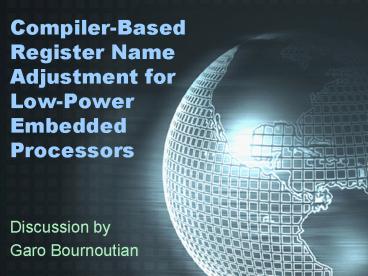Compiler-Based Register Name Adjustment for Low-Power Embedded Processors
Title:
Compiler-Based Register Name Adjustment for Low-Power Embedded Processors
Description:
... compilers allocate registers with minimal amount ... Register PermuTation ... Presented compiler-driven, power-aware register name adjustment (RNA) algorithm ... –
Number of Views:22
Avg rating:3.0/5.0
Title: Compiler-Based Register Name Adjustment for Low-Power Embedded Processors
1
Compiler-BasedRegister Name Adjustment for
Low-PowerEmbeddedProcessors
- Discussion by
- Garo Bournoutian
2
Introduction
- Problem High power consumption due to bit
transitions on instruction bus - Current compilers allocate registers with minimal
amount of spill/fill code - Importance Growing number of mobile,
battery-powered devices. - Solution allows for longer battery-life, larger
die sizes - Approach rearrange, rename registers in code to
allow for minimal bit transitions
3
What is a bit transition?
- Assembly Code Instruction Word
- add r3, r2, r4 0011 0010 0100
- sub r6, r3, r5 0110 0011 0101
- sub r3, r2, r6 0011 0010 0110
- mul r4, r4, r5 0100 0100 0101
- Transitions / field 7 4 5
- Total transitions 16
4
An Example
- The original code had a total of 16 transitions
- add r3, r2, r4
- sub r6, r3, r5
- sub r3, r2, r6
- mul r4, r4, r5
- The optimized code now has a total of 10
transitions - add r6, r2, r4
- sub r7, r6, r5
- sub r6, r2, r7
- mul r4, r4, r5
- Just renaming r3 to r6 and r6 to r7, you have a
37 reduction of bit transitions.
5
Formulation
- Must map code in basic blocks to numerical
structures - ld r5, (r1)0
- add r3, r2, r5
- add r4, r3, r2
- mul r3, r4, r3
- st r3, (r7)10
6
Heuristic Solution
- Solving this problem for multiple basic blocks
and literals is NP-Complete (Traveling Salesman
Problem) - Effective, efficient heuristic solution for RNA
requires two steps - Register PerturBation (RPB)
- Maximizes distribution skew of register pairs
- Register PermuTation (RPT)
- Uses frequencies of register pairs to minimize
hamming distance
7
Register PerturBation
- Commutativity Transformation
- add,mul, and, or operations
- No side-effects in code performance
- Linear Time Complexity
- Dead Register Reassignment
- r1 ? r2, r3 r1 ? r2, r3
- r4 ? r1, r2 r2 ? r1, r2
- r2 ? r3, r4 r2 ? r3, r2
- Linear Time Complexity
8
Register PermuTation
- Capture utilization frequency of register/literal
pairs by means of Register Histogram Graph (RHG) - Directed graph
- Nodes registers/literal
- Edge between two nodes whose registers are
consecutive in the code - Iterative search finds optimal encoding between
each pair. - Complexity of O(ER2) R set of all
registers - E number of edges
9
Application of Heuristic
- Applied primarily on major application loops
- Special care taken to preserve def-use chains
between loops - Adds trivial number of instructions at hot
spots - Profile information may be used to prioritize
which order to visit basic blocks - Can be used within compilation system or as
stand-alone tool operating on binary code
10
Experimental Results
(How they supported their findings)
- Used modified version of SimpleScalar
- Made Control Flow Graph for each Hot Spot
- Generated Basic Block Frequencies
- Encapsulated RPB and RPT into stand-alone module
- Input the generated CFG into this module
- Ran module on six different benchmarks
- RPT Improvement as high as 25
- RPB Improvement as high as 44
11
Conclusions
- Presented compiler-driven, power-aware register
name adjustment (RNA) algorithm - Formally defined as NP-Complete
- Two efficient heuristics for attacking problem
- RPB commutativity and dead register
reassignment - RPT register pair frequencies and remappings
- Significant power improvements resulting from
compiler-based optimization (no additional
hardware support needed) - Independent of ISA
- Easily integrated within any compilation framework































